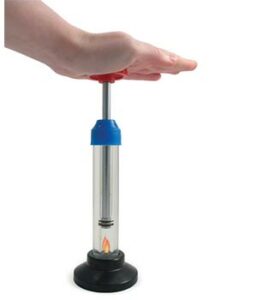 by: Tami O’Connor
by: Tami O’Connor
The fire syringe sold by Educational Innovations is a wonderfully simple, yet impressive and dramatic demonstration that increasing pressure on a gas increases its temperature. 
The fire piston, predecessor to the fire syringe was once used as a means of kindling fire in prehistoric Southeast Asia and the Pacific Islands. The apparatus used a hollow cylinder, sealed at one end and open on the other. A piston fit snugly in the cylinder and by sharply compressing the air, the tinder would ignite. This is an example of compression ignition.
This is also the principle behind a diesel engine. Unlike gasoline engines, diesel engines do not have spark plugs. Rather, the upward movement of the piston compresses the fuel vapor and increases the temperature to the point of combustion. That forces the piston down thus turning the drive shaft.
Here is how best to operate a fire syringe:
Place the piston into the mouth of the cylinder and thread the collar back onto the syringe. Place the syringe on a sturdy table. Get a firm grip on the handle and force the piston straight down, FAST AND HARD. The compression of the air causes the temperature of the gas to rise rapidly, igniting the material at the base of the cylinder. If the compression is done too slowly the heat will dissipate before ignition will occur. This can take a little practice, so don’t be discouraged if it doesn’t flash the first time you try it. It may be helpful to prepare a few pieces of toilet paper or cotton fiber in advance.
Even if you don’t get a flash, you may see a little puff of smoke. Either way, the oxygen in the cylinder will have been consumed, so you will need to remove the collar and retract the plunger. Use a pencil to remove the used material from the cylinder. Removing the pencil will also displace the “used” air from the cylinder, allowing fresh air to refill the cylinder.
The Fire Syringe is very sensitive to moisture, so, to insure the proper results, you should clean the apparatus thoroughly before its first use. Be sure to avoid cleansers or solvents. Simply wipe the piston thoroughly using a clean, dry paper towel. Next, twist a piece of paper towel into a long slender swab, and clean the chamber all the way to the bottom. The goal is to remove any oil from the inside of the chamber.
Next, place a small piece of dry material in the chamber of the syringe. Paper or cotton fibers are common samples. Our personal favorite is toilet tissue. It is helpful to store your fuel fibers in a desiccator, if you have access to one. After ensuring you have a dry piece of toilet tissue (not the kind that contains “lotion”), tear off a small piece (about 1 cm square). To ensure the paper doesn’t pick up moisture from your hands, handle the sample with tweezers. Crumple the paper slightly, and push it to the bottom of the chamber with a pencil or other long thin object. An unwound paper clip works well.
This demonstration is best when performed in a darkened room. This was always one of my students’ favorites, so you might want to prepare yourself to repeat this demo several times!
For more interesting science videos, visit Veritasium.
WARNING: NEVER use flash paper, as it could cause the Fire Syringe tube to shatter. We always recommend wearing safety glasses when using this product.